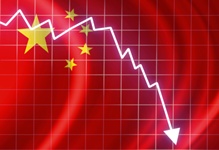 Export-oriented provinces in the Chinese economy have turned pessimistic and anticipate exports will only grow at the rate of five percent this year. In 2012, they targeted an export growth rate of eight percent to 10%.
Export-oriented provinces in the Chinese economy have turned pessimistic and anticipate exports will only grow at the rate of five percent this year. In 2012, they targeted an export growth rate of eight percent to 10%.
What’s troublesome about this is that exports from the Chinese economy account for 20% of the country’s gross domestic product (GDP). This means that, if exports fromChinato other countries decline, the Chinese economy will suffer an economic slowdown. (Source: Epoch Times, February 7, 2013.)
The Chinese economy has become fragile due to the economic slowdown in the global economy. Its biggest trading partner, the eurozone, is still suffering, while other areas have anemic demand.
As export volume falls inChina, it is creating trouble forChina’s manufacturing sector. The Chinese Purchasing Managers’ Index (PMI) declined to 50.4 in January from 50.6 in December of 2012. (Source: National Bureau of Statistics ofChina, February 1, 2013.) A reading above 50 means expansion in manufacturing, while a reading below 50 means contraction. January’s reading is not far from the pivot point into manufacturing contraction.
Getting a read on the Chinese economy is not that easy. Some say statistics out of China are not that reliable. But here is the official word from the Chinese government: in the third quarter of 2012, GDP in the Chinese economy rose 7.4% from a year earlier—the slowest growth rate in three years. (Source: China Daily, December 30, 2012.)
While time and more data will make the picture clearer, with Chinese exports stumbling, a contraction in manufacturing activity could be next for the Chinese economy.
And it’s a domino effect. If an economic slowdown in the Chinese economy does escalate, you can expect that U.S.companies doing business there will see their profits decrease.
The Chinese economy is very dependent on demand from the global economy and that demand remains soft. (Forget the eurozone troubles; as we just witnessed, the U.S.economy contracted in the last quarter of 2012.)
The Shanghai Composite Index, an index of all stocks traded on the Shanghai Stock Exchange, remains down 31% from its 2009 high. If China’s stock market is a leading indicator, we’d better watch out.
The eurozone credit crisis is taking center stage once again. As I have been saying in these pages, it is far from over, even though the European Central Bank (ECB) has announced that it will do “whatever it takes” to save the eurozone. Economic conditions in the region are still deteriorating.
The debt-infested countries in the eurozone are reaching their lows with widespread economic slowdown, but I am more concerned that the stronger nations are starting to show signs of struggle as well.
France, the second biggest economic hub in the region, is in a period of next to no growth. The country’s unemployment is higher than 10% and increasing. The International Monetary Fund (IMF) expects growth between 0.3% and 0.4% for the French economy this year. (Source: Wall Street Journal, February 12, 2013.)
In the fourth quarter of 2012, the eurozone countries saw the steepest quarterly decline in industrial production in more than three years. Industrial production in the eurozone declined 2.4% in the fourth quarter, compared to a meager increase of 0.2% in the third quarter—the sharpest decline since the first quarter of 2009. (Source: Wall Street Journal, February 13, 2013.)
Looking ahead, it seems the credit crisis in the region is there to stay. According to a study conducted by Ernst & Young, banks in the eurozone have a massive amount of bad loans sitting on their books. The auditing firm estimated that these bad loans make up a grand total of $1.23 trillion, or 7.6% of all the loans issued in the region. (Source: Deutsche Welle, February 11, 2013.)
Dear reader, the truth of the matter is that things are not looking very positive for the eurozone. The credit crisis, which caused Greeceto fall into depression and countries like Spain,Italy and Portugal to experience severe economic conditions, is spreading.
As long as this credit crisis in the eurozone continues to take a toll, the U.S.economy will feel its effects. Consider this: in 2012,U.S.companies exported $265.1 billion worth of goods to eurozone nations. (Source: Census Bureau, last accessed February 13, 2013.) If the eurozone’s economy continues to suffer, so will American company exports to the region; and, with that, 40% of S&P 500 companies that derive some of their revenue from Europe will see added earnings pressure.
What He Said:
“If I had to pick one stock exchange that would rank as the best performer of 2007, it would be the TSX (Canada’s equivalent of the NYSE). Interest rates inCanadaremain very low and they are not expected to rise anytime soon. Americans looking to diversify their portfolios, both as a hedge against the U.S. dollar and a play on gold bullion’s price rise, should consider the TSX. Most brokers in theU.S.can buy stock on this exchange.” Michael Lombardi in Profit Confidential, February 8, 2007. The TSX was one of the top performing stock markets in 2007, up just under 20% for the year.